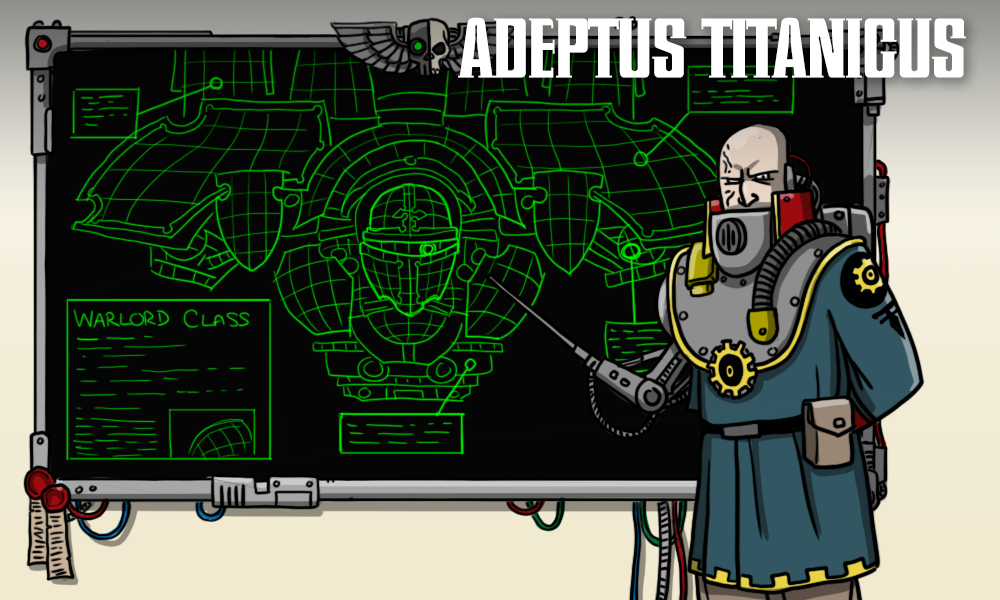Welcome back to Goonhammer’s series for aspiring Titan Principes. We here at Goonhammer’s own Collegia Titanica know that Adeptus Titanicus can seem intimidating to players unfamiliar with its particular quirks, but this series aims to equip you with everything you’ll need to play out epic clashes on the battlefields of the far future with your very own Titan Battlegroup. In this series, we’ll be walking you through how to build your battlegroup and command it to glory, including everything from which Titans to include and how to equip them, through to how to command them on the field of battle to secure ultimate victory.
While Knights are as big as they come in 40K, they’re merely anklebiters in a game about God-Engines. Don’t discount them based on their size though: together in groups and with some clever positioning, these miniature mechanical marvels can even challenge a Warlord Titan.
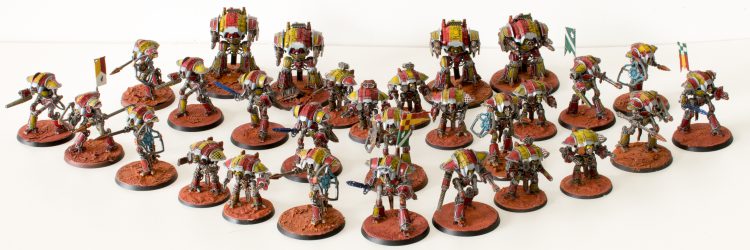
Knights in a Nutshell
As a result of their size, a good chunk of the rules apply differently to Knights – and some don’t apply at all. Due to the scale of the game, Knights are fielded in banners, which normally are a group of Knights led by a Knight Scion. Think of a banner like a squad from 40k, with the Scion as the Sergeant equivalent. Knight Banners work more or less like you’d expect a squad to work if you’ve played other wargames. They have to stay in coherency, they get bonuses from keeping their Scion alive, and if they take too many casualties, their morale can break and their effectiveness will suffer.
Knights can be fielded in two ways: as Support Banners for your Titan battlegroup, or as a complete Household Force consisting solely of Knights. For now, we’re only looking at how Knights work in Support Banners attached to a Titan battlegroup – this is by far the most common way you’ll run into these units, and it’s a lot easier for someone starting the game to splash in a banner or two instead of building and painting an entire force with as many models as some 40k lists. Besides, for many players, the big draw of Adeptus Titanicus is right there in the name, so we don’t anticipate you’ll run into a lot of Household Force lists. Don’t worry, though – if you’ve always dreamed of fielding an entire Household resplendent in all its glory, we’ve got you covered in the Knight Household focus.
Strengths
- Ion Shields: Knights don’t have the benefit of the nigh invulnerability granted by void shields and instead use their combined ion shields to deflect incoming fire. Mechanically, this works like an armor save from 40k, with successful saves negating damage and failed saves resulting in the Knight taking a point or two of structure damage. The target number for the save varies depending on the number of Knights remaining in the banner and the strength of the incoming shot. However, unlike Titans’ void shields, ion shields don’t have a capacity which means you’ll always get a save against low strength attacks no matter how many you fail. On the flip side, high strength attacks such as plasma or volcano cannons will bypass this and possibly kill a Knight with a single shot! Another subtle difference is that Ion Shields can apply in melee combat, helping you shrug off small arms fire.
- No firing/movement arcs: Due to their (relative) agility, Knights are regarded as having no arcs for the purposes of movement or firing. This gives you some incredible flexibility, letting you move or shoot in any direction. This is especially useful on terrain dense tables where larger engines might have trouble navigating – since Knights don’t have a forward arc, they also don’t need to turn to run around obstacles. Additionally, their small and relatively nimble chassis can often ignore the effects of difficult terrain, letting them go more or less where they want. Finally, not having side or rear arcs means they can’t be flanked, and will always be able to shoot at a target within range and line of sight (assuming they live long enough). This doesn’t mean their movement is completely free-form. While Knights may not have a front arc and don’t have to turn, the FAQ makes clear that, when issued the charge order, they have to move directly forward and can’t change direction. This isn’t usually a huge deal, but a canny opponent can feed you a sacrificial model to eat a charge and cut down on the number of attacks you’ll get later in the combat phase.
- Consistent: Unlike their larger brethren, Knights don’t have to worry about machine spirits, reactors, or the catastrophic damage table. This allows you to be relatively certain with what to expect out of a banner on a given turn.
- Relatively Cheap: Banners can generate a large amount of threat given the amount of investment into them – Don’t be afraid to play aggressively or even use them as sacrificial pawns while your other elements move into position.
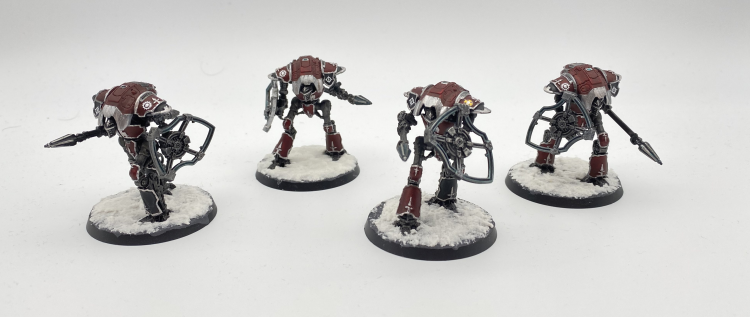
Weaknesses
- Ion Shields: While the Knights’ defensive barriers are useful, ion shields have a serious flaw: their effectiveness degrades as the strength of the weapon directed at them increases. If that shot is strong enough, it might even ignore the shields altogether and go straight to an armor roll. While your ion shields will let a full banner weather weaker weapons more or less consistently, one shot from a belicosa could spell doom for an entire banner.
- Diminishing Effectiveness With Damage: As your Knights are destroyed, the banner loses effectiveness – rather than just being a few points of damage to armor, losing a Knight means losing firepower in the combat phase with no way to bring it back. Additionally, each time a Knight is destroyed, its comrades in the banner have to take a command check or become shaken, making them less effective in the next round of combat.
Piloting Your Knights
In General
The movement phase often dictates the victor in Adeptus Titanicus, and Knights are well-equipped to take full advantage of it. Use your amazing mobility to keep out of arcs and duck between cover to deny your opponent shots while you get into position to take them down. Even more so than with Warhounds and Reavers, you’ll need to take care in your movement to make sure you don’t leave them vulnerable – even the relatively durable Knights Acastus will die immediately if they take a single critical hit.
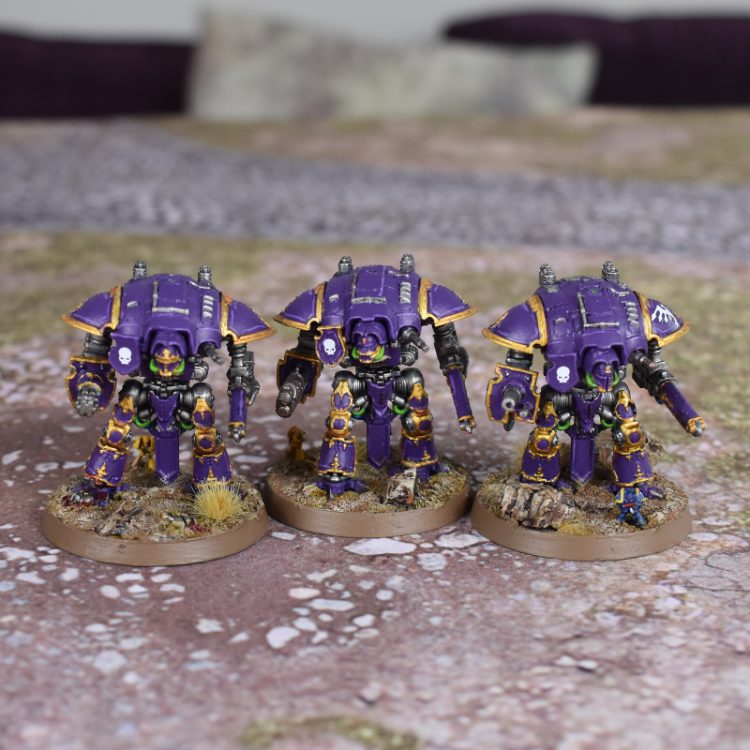
Questoris Knights
- Strengths
- Cheap: Questoris are priced to move, with a base banner of three going for 120 points without weapons. This makes taking a full banner of six of them much more palatable, giving you some ablative wounds and a better ion save against all but the most powerful attacks.
- Flexible: Questoris have a wide array of weapons, allowing them to strip void shields at range or close in melee and threaten even the largest engines on the field. You’ve got the tools available to equip your banner to fill the role you need it to.
- Disposable: Despite their cost and relative fragility, Questoris can still do a lot of damage if they’re able to bring their weapons to bear, and their ability to clog up the board and cut down the enemy’s movement options means they’re going to draw some hate at some point. That’s fine, though – it takes a few shots to chew through a full banner even under the best of circumstances, and every Belicosa or Melta shot that kills a Questoris is one that didn’t crack open your Reaver’s armor.
- Weaknesses
- Weak at Range: Questoris Knights need to see the whites of their eyes to really start doing damage. Your weapons are all fairly short-ranged, topping out at 24”. You’ll have to close the gap to take advantage of bonuses to hit at short range, open opportunities to get flanking bonuses, and hopefully get inside your opponent’s void shields so you can ignore them entirely and put the hurt on armor.
- Poor durability unless massed: Questoris Knights die in droves when shot at and can be threatened by any weapon in the game. An entire banner can vanish in an instant if it draws the attention of a volcano, melta or plasma weapon. You can mitigate this by taking a lot of them to increase the ion save and give them some more ablative structure points, but this also means you’ll be rolling more command checks with more opportunities for them to become shaken over the course of the game.
Questoris are cheap and come in larger banners, but they’re not that tough to kill. Play them accordingly. Clog up the board to keep keep your opponent boxed in so the rest of your battlegroup can fight at advantage. And if you can manage to get in close enough to take advantage of your short ranged weaponry, they can deal a ton of damage. Just be careful that you don’t leave them exposed to any powerful ranged weapons while they’re crossing the board.
Weapons
Questoris have the most customization of any knight, letting you mix and match their equipment to fill the role you want them to fill.
- Rapid-Fire Battlecannon: Your go-to ranged weapon. Basically a Reaver gatling cannon that only gets two shots, but you can cram a ton of these into a squad to hammer down shields and do respectable damage to armor, especially if you’re taking advantage of your high speed to outflank your target.
- Questoris Melee Weapon: This is the good stuff. Cheap at 5 points with a respectable strength 7 and the ability to call shots without penalty. The downside is its 2” range, which is less of a problem here than on Titans due to your improved maneuverability. A Questoris banner with a good number of these scattered through it will shred whatever it runs into, assuming it lives long enough to get there.
- Thermal Cannon: A strength 8 weapon with the fusion trait, a few of these in a banner will do horrendous damage to armor if you can close to within 6”. If you want a backup option in case you’re not able to close to within 2” to use the melee weapon, you could do worse than sprinkling a few of these in.
- Avenger Gatling Cannon: Trap choice in Titan battlegroups – at first glance, its 8 shots with the rapid trait make it seem like an up-gunned vulcan megabolter, until you realize that it’s strength 3, meaning it’s incapable of forcing void saves and cannot damage anything in the game without at least a +1 to armor rolls. If you’re taking a Knight Household list, you might be able to make this work, but we don’t recommend it – spend your points making good choices into great ones, not making bad options merely OK.
- Stormspear Rocketpod: 3 strength 5 dice at 16” for 15 points. Not particularly inspiring, but not really terrible either. Adding one of these to a Questoris with an RFBC makes it almost as effective as a gatling cannon into voids, and reasonably effective into armor from the rear or sides. Don’t go overboard on these, but consider throwing a few in if you’re got room in your list.
- Meltagun: An auto-hitting strength 8 shot during the combat phase on a target within 3”. Rules as written, it’s unclear whether you can call your shot with this, but due to the order of how things happen, we don’t think so. If we’re wrong, adding a few of these to a banner could add some punch to your banner, but you’re probably better off taking the Stormspear instead, or just saving the points.
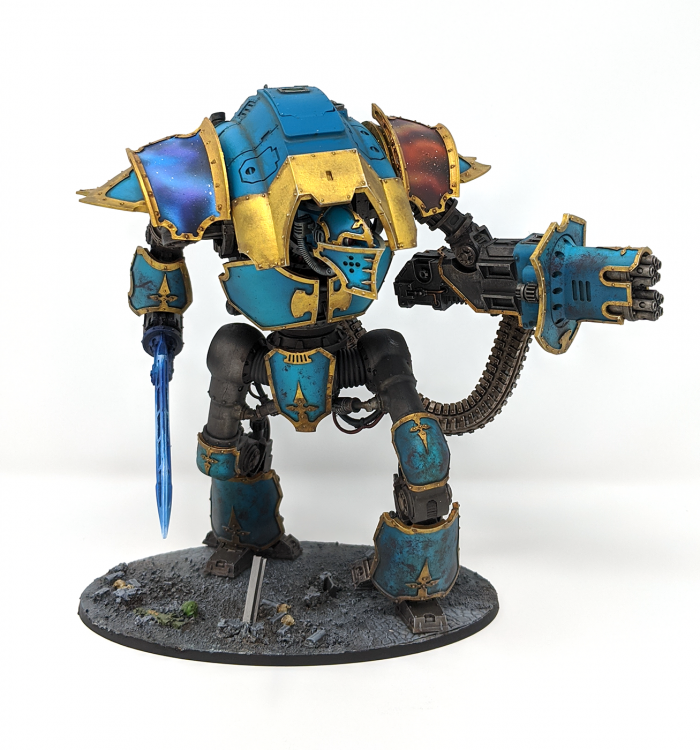
Cerastus Knights
- Strengths
- Fast: If you’ve gotta go fast, Knights Cerastus are for you. Moving 12” a turn (24” with full stride), they can very quickly close the gap into striking range, making them a serious threat from the moment the game starts.
- Powerful Weaponry: Cerastus are capable of single handedly taking down a Warlord Titan in the right conditions if unchallenged. A banner of Lancers charging out of cover can roll an utterly absurd number of dice with their shock lances, and we’ve seen more than one game rescued from the jaws of defeat after a well-timed charge.
- Weaknesses
- Expensive for Knights: Cerastus Knights require a bit of investment to field. A banner of three puts you at 250 points with lances which makes them more expensive than a Warhound Titan. They can often struggle to make back their points without some clever play on your part. When they strike true, however, you’ll be eager to forgive them – these ones hurt.
- Poor durability without a Lancer: Without the shield, Cerastus are nearly as fragile as Questoris, and can’t bring as many hulls to pad out their save to boot. Almost every Cerastus banner will want at least one Lancer for the +1 to ion saves from the shield.
Cerastus are blazing fast, moving 12” in any direction, and their melee weapons are absolutely terrifying. Try to set up long charges so you can get as many attacks with your melee weapons – if you can pull off the full 12” charge, you’ll get 6 strength 8 attacks with the melee trait, more than enough to put any princeps into a cold sweat. Acherons trade some close-combat reliability for a flame cannon, which gives them a bit more punch when they can’t quite make the charge and makes them great for void breaking duty. Castigators and their bolt cannons have somewhat limited use outside of Knight households due to strength being too low to impact voids.
Weapons
- Cerastus Shock Lance and Ion Gauntlet: Your go-to. A reliable and effective melee threat paired with a respectable durability boost. And don’t forget about the shield’s shock blast – its 2 strength 6 shots aren’t amazing, but could make the difference on a wounded target. Try to set up long charges with these models to get the most mileage out of the shock lances.
- Acheron Pattern Flame Cannon and Acheron Chainfist: Another interesting choice, the Acheron Chainfist trades a point of strength and a point of accuracy for the Rending trait, giving it the potential to spike higher than the shock lance at the expense of some consistency. The flame cannon is a Warhound inferno gun with one fewer die strapped to a chassis that can run 12” without having to risk overheating. All in all, a perfectly fine choice, and worth considering splashing into a banner with a Lancer or two.
- Castigator Pattern Bolt Cannon/Warblade: Trap choice outside of Knight Households. The warblade is identical to the Acheron chainfist and the bolt cannon is a worse version of the Questoris’s avenger gatling cannon, unable to peirce voids.. Don’t pick it.
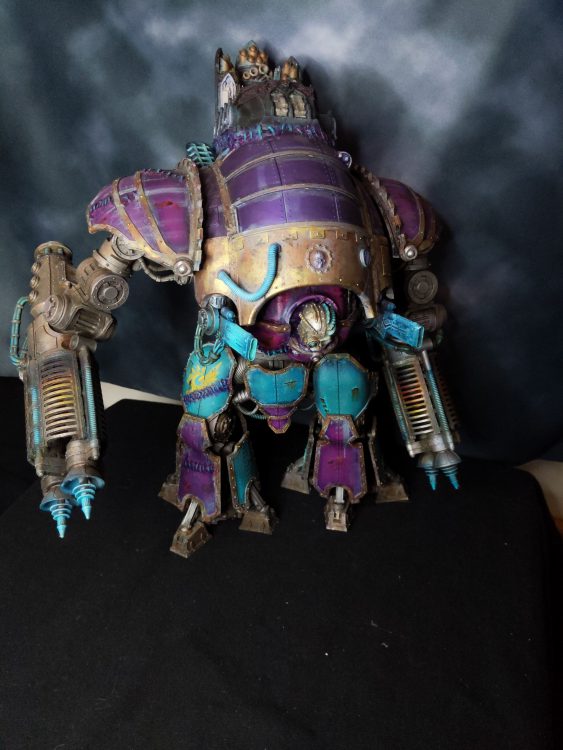
Acastus Knights
- Strengths
- Tough: Acastus Knights are very hard to dislodge with their 7 hull points and high target numbers for armor rolls, making it nearly impossible to deal a critical hit unless they’re fired on by a volcano cannon or plasma on Maximal Fire.
- Powerful: Acastus Knights strike fear into anything they face, as they are effective against all targets, firing 4 shots with a respectable strength value at extreme range. They shred voids, blow Knights clear off the table, and will do horrifying amounts of damage to any Titan armor they’re able to hit.
- Weaknesses
- Restrictions: Not only does their revised cost in the FAQ reduce the number you can take, the Auxiliary Support Banner rule means that you can only take a single banner per Maniple or Lance in your battlegroup which significantly reduces the number you can field.
Acastus are slower than their knightly brethren, but their long-ranged firepower means they don’t really care. In addition to sporting 4-shot weapons at strength 8 or higher, they get even scarier if you issue them the Split Fire or First Fire order, upgrading their 4+ BS to a more respectable 3+. You’ll want to set these up in a fire support position with nice, long firing lanes, then use your other models to herd your opponent into the kill zone.
Weapons
- Twin Magna Lascannon/Ironstorm Missile Pod: Otherwise known as the Porphyrion, this is the only loadout that currently has official models available. The Magna Lascannon drops 4 3” blast templates at strength 8 up to 48” away. With its BS of 3+ when issued Split Fire or First Fire orders (which you’ll be doing frequently), it’s not unreasonable to expect 3 direct hits per volley, resulting in 6 hits on target. This allows you to easily strip shields if they aren’t down already or pummel away at armour. The Ironstorm missile pod is effectively a longer ranged megabolter – 36” with 6 dice and the Rapid trait makes this an excellent option to strip voids before opening up with the magnas.
- Twin Conversion Beam Cannon/Karacnos Mortar Battery: The Asterius pattern is probably the stronger of the two loadouts. This is mostly on account of the conversion beamer having one more strength than the magna lascannon, increasing your chances of devastating hits and dropping large templates over 24” – enabling you to vaporise banners of Knight Questoris entirely. Its Karacnos mortar battery is somewhat underwhelming, though – the long range of the c-beamer means you’re probably going to be shooting from across the board, limiting your ability to flank to take advantage of the Ordnance trait into side or rear armor.
- Twin Autocannon: If that isn’t enough firepower, you also have another weapon which can inflict an automatic hit within 6” to try and strip of that final shield before you open fire. Not something you’ll get a lot of use out of, but don’t forget you have it if something closes.
- Twin Lascannon: If the Autocannon doesn’t strike your fancy, for 10 points you can upgrade this to a weapon with 12” range with 2 Strength 6 dice. Generally not worth it, though, as your Acastus will typically be firing from far away from its targets.
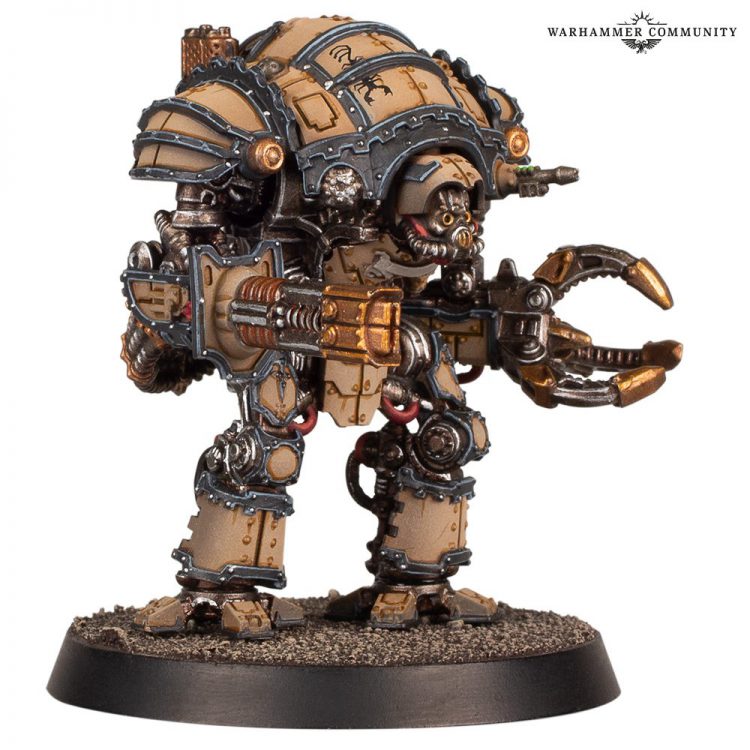
Mechanicum Questoris Knights
- Strengths
- Cheap and Efficient: For the same investment as three Questoris Knight Gallants at 150 points, a minimum Styrix banner is a great source of a cheap activation to fill out your list thanks to it’s durability given by Ionic Flare Shield and Blessed AutoSimulacra.
- Voidbreaking: Styrix Knights are great at picking apart void shields, making them an excellent choice of support banner
- Weaknesses
- Low Strength Ranged Weaponry: Whilst capable of dropping voids and damaging other knights, they will struggle against piercing armor on the larger targets.
The Styrix and Maegara are more durable and focused versions of their Questoris cousins. The Ionic Flare Shield trait reducing incoming blasts by 1 strength may not seem like much, but consider that blast weapons are the most common anti-knight weapon and 1 less strength makes all the difference – Plasma Blastguns with Maxmimal Fire can no longer get critical hits, and a belicosa comes in at strength 11. We recommend taking a pair of Styrix for their Volkite Chieoroviles as a cheap list-filler with potential upside into voids.
Weapons
- Volkite Chieorovile: Fantastic support weapon for voids, it adds additional hits whenever it hits a Titan with voids up. It’s not great against armour, but that’s not why you’re taking it. As written, it’s a bit unclear how the Voidbreaker rule even works, but we think the best reading right now is that it forces 1 additional save per phase on each target the Banner fires them at. Additionally, we have absolutely no clue how to pronounce “Chieorovile.”
- Hekaton Siege Claw: Rending gives you the ability to potentially hurt larger titans, although we recommend Cerastus for a dedicated melee platform – this’ll do the job in a pinch, but it’s not why you’re bringing them.
- Graviton Gun: Being able to easily concuss an Titan is a great trick to have, try and bring one per Banner just in case. You’ll frequently have at least 10 points to play with in your list, and this is a great cheap option. Just don’t expect it to do much on the armor roll, and prioritize enemy Titans that are grouped up or hiding near buildings, then watch the chaos.
- Lightning Cannon: Unfortunately too low strength to really be that useful. If you need templates for taking out other Knights, try and use your points on Acastus Knights.
- Phased Plasma Fusils: Free hits at strength 4. Fine, we guess.

Building Your Banners
Knight Banners can fill various roles to complement your battlegroup. Here are some ways you could use them in your own list:
Death on a Stick – A Cerastus banner of three comes in around 250 points, slightly more than your average Warhound build. And taking 3 is worth considering, as this provides improved durability and some mitigation for unlucky crits without over-investing. With their incredible speed, they will close into effective weapon range quickly and draw a lot of heat in the process. The Scion in this unit should probably be a Lancer, as while they stand the unit gets a +1 to their ion shield saves. After the initial Lancer, the rest of the unit can be made up of either Lancers or Acherons as to your preference. The Flame templates from the Acheron can be used to help clear out opposing knights or help drop voids on a Titan they are closing on if you’re not able to make your charge, allowing other models finish the job. When the unit does make it into melee, they can pay dividends on your investment by doing horrendous damage to an opposing Titan.
Death from Afar – A solo Acastus Knight Banner is a great investment for the amount of pain they will inflict on your opponents. Preferably equipped with c-beamers (although they currently lack an official model), they can threaten any target on the table. You’ll be hard pressed to find a better way to fill that last 200~ points in your list than a model that can out-shoot a Warhound at much longer range. Remember that you are limited to a single banner per Maniple/Lance thanks to the errata, so you’ll probably end up lumping them together if you want to take more than one at most point limits.
The Swarm – While not as immediately intimidating as their larger brethren, a full banner of mostly melee Questoris Knights has its uses. If they close the gap they can wail on targets in a flank and be rather annoying to deal with. Consider adding a few stormspear rocket pods or rapid-fire battlecannons to help with shield breaking as you move up the board, or splashing in a few thermal cannons for some additional punch in close if you’ve got room in your list, though taking too many can add up fast. Be mindful of high strength blast weapons, and stick to cover as you advance across the board. Once they make it in, use their maneuverability to stay out of their target’s line of fire and keep them right where you want them.
Soggy: A full banner of Questoris Knights paired with the Outflank stratagem can be a serious threat – at Warhammer world we saw a banner equipped with Thermal Cannons deploy within voids behind a Warlord in the corner and melt it apart.
Thrifty Voidbreakers – A pair of Styrix equipped with twin Volkites is a cheap investment of 160 points for breaking voids with 12 shots with the Voidbreaker trait.
Legion Synergies
Some Legios have special interactions with Knights or otherwise work well with them. Here are a few of them:
- Gryphonicus – Legio Gryphonicus Princeps get to call dibs on opposing Titans, getting benefits to hit and armor rolls as long as they are the only Titan that targets them. This won’t stop your Knight banners from helping out a little, though. Questoris Knights with rapid-fire battlecannons and stormspears can help drop shields as you close, and Acastus Knights are great at adding a little more punch from across the table.
- Dauntless – Any Banners within line of sight a Dauntless titan get to re-roll command checks to avoid becoming shaken, helping make sure an unlucky crit won’t hamper your next activation.
- Defensor – The Icon of the True princeps trait lets you add 1 to command checks for Titans and Knights so long as your princeps is on the board. Another way to avoid becoming shaken, though it requires you to give up your personal trait to access it.
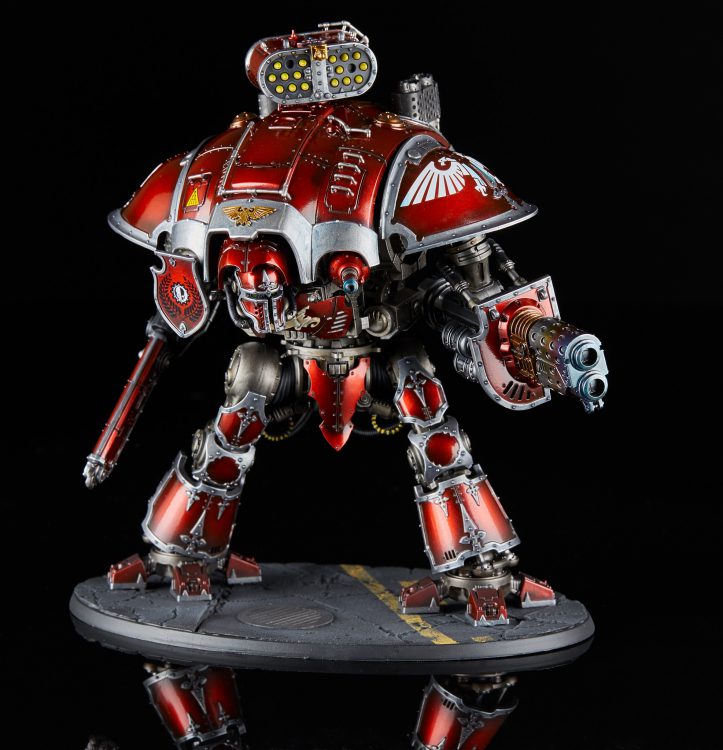
What’s Next?
Knight Banners have a lot to offer for their point investment and are a great add-on to any maniple. If eventually you find you have picked up enough Knight kits to bring a whole force of them check out our Knight Household Focus, which adds additional mechanics representing how Lances of Knights fight together to take down God-Engines.
